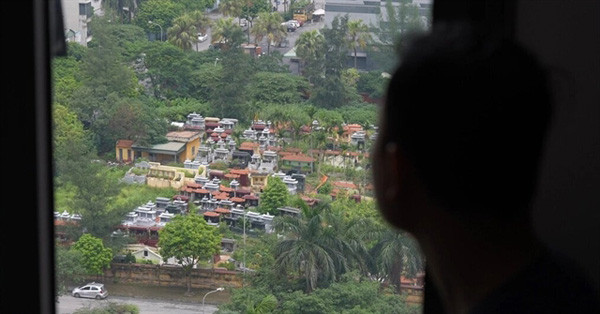
Pham Quoc An, who lives in Phu Thinh Green Park in Ha Dong District, said the view from his apartment window is taken up by the grey-white tombstones of a cemetery.
An lives just 100 metres away.
"In the morning when I have a day off, I want to go out to the balcony to enjoy the view, but my eyes immediately fall on that cemetery,” he said.
"Although I bought this apartment for less than other apartments that don't look out over the cemetery, I still feel weird," he said.
A woman living in Yen Hoa Ward, Cau Giay District said she had lived in the ward’s Cot Village for 30 years.
Her house is only several metres away from the village’s cemetery.
“Although I have lived in the house 30 years, I am still not used to the smell of incense smoke filling up my house when someone visits a grave,” she added.
Causes
Tran Ngoc Chinh, the chairman of the Vietnam Urban Planning and Development Association, talked to Zing online newspaper and blamed urbanisation for the situation.
In the past, Hanoi only consisted of four inner districts; Hoan Kiem, Hai Ba Trung, Ba Dinh and Dong Da. However, the capital has since expanded, he said.
Usually, the villages outside of the city centre had their own cemeteries. As the city expanded, these villages were absorbed into the city proper, Chinh said.
According to Chinh, in the process of urbanisation, cemeteries located in expanded urban areas are common in all major cities of Vietnam.
There are similar situations in urban areas of cities like Tokyo and Paris.
However, in foreign countries, the cemetery is designed with rows and landscapes. It becomes a place of cultural and spiritual activities for local people.
In Vietnam, only some large cemeteries are planned in a neat and orderly manner; many small cemeteries failed to do so.
Recommendations
Chinh said in theory the simplest solution would be to move all the graves from residential areas and gather them in large cemeteries according to the plan.
“But it is not so simple in reality,” he said.
"Real estate investors often hesitate when implementing projects that need to relocate cemeteries because of spiritual issues," he said.
"Therefore, for now, we still have to respect and accept the existence of cemeteries in urban areas," he said.
However, managerial agencies need to find ways to renovate and build the landscape of the cemeteries to match the urban space.
"It’s a matter of how to make a harmony space between the living and the dead,” he said.
Le Thi Cuc, the author of the book “Funerals of Buddhists and Catholics in the north” said that the model of a cemetery park located far from urban areas would be one of the solutions to the situation.
Concepts that graves must be located in cemeteries near the residence of a part of the people would have to change to match with the development trend, she said.
However, the cost of owning a grave in the cemetery parks on the outskirts of the capital was often quite high and low-income people cannot access them, she said.
Therefore, the solution in the future would be to plan more cemetery parks with more reasonable prices, she added.
"People should be encouraged to practise cremation instead of burial and keeping the ashes of the deceased in a small area to ensure space-saving", she said.
The capital has seven large-scale cemeteries; Mai Dich, Van Dien, Thanh Tuoc, Yen Ky, Sai Dong, Ngoc Hoi and Nhon, with a total area of about 70 hectares.
The city’s current area is three times more than the city's old area after expansion and the urban population is expected to reach 10 million by 2030. Therefore, building new cemeteries is an urgent and pressing need.
Planning
According to the city’s master plan by 2030, a vision towards 2050, the city will close the cemeteries of Sai Dong and Van Dien.
Vinh Hang cemetery will be expanded from 37 hectares to 87 hectares, serving the burial needs of people and gathering graves in the southern area of the Hong (Red) River.
In the northwest area of the city, Thanh Tuoc cemetery will be renovated and expanded into a cemetery park with a scale of 23 hectares by 2030.
The city will also build new cemeteries of Minh Phu and Bac Son in Soc Son District; Xuan Non cemetery in Dong Anh District; Trung Mau cemetery in Gia Lam District; Tran Phu cemetery in Chuong My District and Chuyen My cemetery in Phu Xuyen District.
Source: Vietnam News